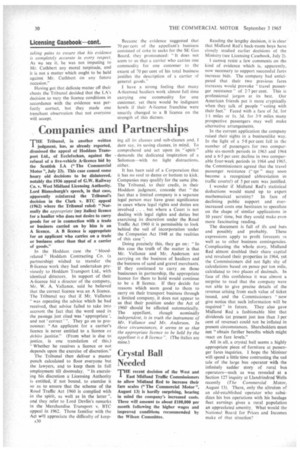Crystal Ball Needed
Page 32

If you've noticed an error in this article please click here to report it so we can fix it.
TH:recent decision of the West and ast Midland Traffic Commissioners to allow Midland Red to increase their fare scales (" The Commercial Motor ", August 13) is hardly surprising, bearing in mind the company's increased costs. These will amount to about £100,000 per month following the higher wages and improved conditions recommended by the Wilson Committee.
Reading the lengthy decision, it is clear that Midland Red's back-room boys have closely studied earlier decisions of the Ministry (see Licensing Casebook, July 2).
1 cannol resist a few comments on the kind of evidence :which is, apparently, now necessary to support successful fares increase bids. The company had anticipated that their two previous fares increases would provoke " travel passenger resistance of 27 per cent. This is professional jargon at its best. Our American friends put it more cryptically. when they talk of people "voting with their feet." Faced with a fare of 5d. for 1-1 miles or Is. 3d. for 3.9 miles many prospective passengers may well make alternative arrangements.
In the current application the company raised their sights in a businesslike way. In the light of a 5-8 per cent fall in the number of passengers for two comparable six-month periods in 1963 and 1964 and a 65 per cent decline in two comparable four-week periods in 1964 and 1965, the Commissioners agreed that the travel passenger resistance (" tor " may soon become a recognized abbreviation in traffic courts!) of 5 per cent was justified.
wonder if Midland Red's statistical deductions would stand up to expert mathematical scrutiny? In face of declining public support and everincreased costs one hestitatcs to speculate on the shape of similar applications in 10 years' time, but they could make even more fascinating reading.
The document is full of ifs and buts and possibly and probably. These expressions apply to profit forecasts is well as to other business contingencies. Complicating the whole story, Midland Red almost doubled their share capital and revalued their properties in 1964, yet the Commissioners did not fight shy of calculations based on pence per ton mile, calculated to two places of decimals. In face of this confidence it was almost a surprise to read that the company were not able to give precise details of the revenue arising from each value of ticket issued, and the Commissioners "now give notice that such information will be required" in future. They also gave Midland Red a fashionable hint that dividends (at present just less than 3 per cent of revenue) could not be inflated in present circumstances. Shareholders must not "obtain further benefits which might react on fare levels."
All in all, a crystal ball seems a highly appropriate piece of furniture at passenger fares inquiries. I hope the Minister will spend a little time contrasting the sad tale of the large bus operator with the infinitely sadder story of rural bus operators—such as was revealed at a Section 127 inquiry at Llandrindrod Wells recently (The Commercial Motor, August 13). There, only the altruism of an old-established operator who subsidizes his bus operations with his haulage fleet earnings gives a rural population an appreciated amenity. What would the National Board for Prices and Incomes make of that situation?




























































































































































